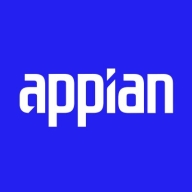


Find out what your peers are saying about Camunda, Automation Anywhere, Apache and others in Business Process Management (BPM).
They see return on investment in terms of cost savings, time savings, more efficient processes, and more efficient employees.
Appian is very efficient, allowing us to build a lot of applications within a financial year, making it cost-effective.
There is enough documentation available, and the community support is good.
Forums and community resources like Stack Overflow are helpful.
Their customer service is responsive, and the team is very prompt for support.
The technical support for Appian rates as 10 out of 10 because they have a great support team.
The technical support is generally good.
The customer service is outstanding.
We had a contract that provided on-site support, which was very satisfactory.
On a scale from 1 to 10, support deserves a rating of 7 to 8.
The solution is very scalable.
Apache Airflow scales well, especially when deployed in Kubernetes environments.
On a scale of one to 10, Appian rates as a nine for scalability.
Initially, without much coding, I can easily handle five thousand records.
Appian is scalable, but it depends on how you build your applications.
The solution has scalability issues; on a scale, I would rate it at eight out of ten.
The architecture of the solution offers scalability; we can scale both vertically and horizontally.
I found IBM BPM to be scalable to a certain level but it struggled with large volumes of concurrent transactions.
I would rate the stability of the solution as ten out of ten.
Apache Airflow is stable and I have not experienced significant issues.
I would rate its stability at nine out of ten.
It depends on how it has been designed and how it has been configured.
The stability of Appian would rate as nine, as it's a stable environment.
It is not suitable for real-time ETL tasks.
There is no dashboard for us to check all the Directed Acyclic Graphs (DAGs); a dashboard would help us analyze the work better.
If we desire to add custom messengers or a rest API, those options are unavailable.
It has room to improve for use cases where the users are public facing, where anonymous users could come to a site and run a business workflow or interact with some data.
If there is a very complex process that includes a lot of data transitioning and memory-centric processes, it consumes a lot of memory.
I would like to see more enhancement in the user interface to allow more freedom in designing the sites and pages.
IBM BPM also lacks smaller solutions, so I must purchase multiple solutions to start with workflows and applications.
Technologies evolve day by day, especially with the emergence of artificial intelligence and generative AI models.
I prefer using the open-source version rather than the enterprise version, which helps manage costs.
It is a sub-feature and not an individual purchase.
Apache Airflow is a community-based platform and is not a licensed product.
On the pricier side, both Appian and Pega are enterprise-level solutions, placing them on the slightly higher side.
The pricing of Appian is based on the number of users and generally ranges from 70 to 100 USD per user per month.
The price of Appian, on a competitive landscape, is a little bit on the higher side for companies, rating maybe a 6.5.
SAP is more expensive, but IBM BPM is very expensive.
Apache Airflow is an open-source platform that allows easy integration with AWS, Azure, and Google Cloud Platform.
Reliability is good, and when integrated with Kubernetes, it performs better compared to on-premises environments.
We can create notifications for successful or failed tasks, providing a practical way to monitor our workflows.
The zero-code integration feature is remarkable, allowing for ease of data transfer and workflow enhancement.
Appian is aiding in leveraging AI technologies in multiple ways: one way is for developers, as they make development efficient and quick by enabling developer co-pilots across various phases of the application, which helps design Appian quickly and provides suggestions along the way.
It is easy for me to define the process and create configurable workflows.
The integration capabilities of IBM BPM are excellent.
| Product | Market Share (%) |
|---|---|
| Apache Airflow | 5.7% |
| IBM BPM | 6.0% |
| Appian | 5.3% |
| Other | 83.0% |



| Company Size | Count |
|---|---|
| Small Business | 13 |
| Midsize Enterprise | 3 |
| Large Enterprise | 24 |
| Company Size | Count |
|---|---|
| Small Business | 20 |
| Midsize Enterprise | 9 |
| Large Enterprise | 41 |
| Company Size | Count |
|---|---|
| Small Business | 30 |
| Midsize Enterprise | 19 |
| Large Enterprise | 71 |
Apache Airflow is an open-source workflow management system (WMS) that is primarily used to programmatically author, orchestrate, schedule, and monitor data pipelines as well as workflows. The solution makes it possible for you to manage your data pipelines by authoring workflows as directed acyclic graphs (DAGs) of tasks. By using Apache Airflow, you can orchestrate data pipelines over object stores and data warehouses, run workflows that are not data-related, and can also create and manage scripted data pipelines as code (Python).
Apache Airflow Features
Apache Airflow has many valuable key features. Some of the most useful ones include:
Apache Airflow Benefits
There are many benefits to implementing Apache Airflow. Some of the biggest advantages the solution offers include:
Reviews from Real Users
Below are some reviews and helpful feedback written by PeerSpot users currently using the Apache Airflow solution.
A Senior Solutions Architect/Software Architect says, “The product integrates well with other pipelines and solutions. The ease of building different processes is very valuable to us. The difference between Kafka and Airflow, is that it's better for dealing with the specific flows that we want to do some transformation. It's very easy to create flows.”
An Assistant Manager at a comms service provider mentions, “The best part of Airflow is its direct support for Python, especially because Python is so important for data science, engineering, and design. This makes the programmatic aspect of our work easy for us, and it means we can automate a lot.”
A Senior Software Engineer at a pharma/biotech company comments that he likes Apache Airflow because it is “Feature rich, open-source, and good for building data pipelines.”
Appian is a unified low-code platform and solution used by businesses to build enterprise applications and workflows. This product adapts to the needs of clients and the technologies they are already using to combine their data in a single workflow and maximize resources. The platform has four main components through which it transforms the work process for companies of various sizes. They are:
Appian is utilized across a diverse set of industries, including automotive and manufacturing, energy and utilities, education, financial services, telecom and media, transportation, retail, insurance, healthcare, and life sciences. The most frequent use cases of Appian are customer journey, governance, risk and compliance, operational efficiency, supply chain, distributed order management, and environmental, social, and governance (ESG) management.
Appian Features
Appian has various features that allow users to create solutions for their businesses. These features can be separated into a few groups according to function, including automation, low-code application development, and integrations and data. Some of the most frequently used features of Appian include:
Appian Benefits
The benefits of using Appian include:
Reviews from Real Users
A practice leader - digital process automation at a computer software company values Appian highly because the product is easy to develop, low-code, and has a good user interface.
Alan G., an advisory board member at Codecon VR, Appian offers a clear application life cycle, easy to learn documentation, and comes with a fundamentals course.
IBM BPM is a business process management tool that provides a robust set of tools to author, test, and deploy business processes, as well as full visibility and insight to managing those business processes. The solution provides tooling and run time for process design, execution, monitoring, and optimization, along with basic system integration support. To support various levels of complexity and involvement with business process management, there are two different editions of the product: IBM BPM and IBM BPM Express.
IBM BPM Features
IBM BPM has many valuable key features. Some of the most useful ones include:
IBM BPM Benefits
There are many benefits to implementing IBM BPM. Some of the biggest advantages the solution offers include:
Reviews from Real Users
IBM BPM is a solution that stands out when compared to many of its competitors. Some of its major advantages are that it’s good for developing complex apps, is robust, and has helpful team management and process performance features.
Zoran C., Owner/CEO at IT SPHERE, says, “It is perfect if you have to develop complex apps without much coding (only java script). It is also good if you don't have much IT resources in your company and would like to involve business analysts in the process of developing apps. My opinion is that it can do about 50% of all developers' work.”
Suhas V., BPM Architect at GBM, mentions, “Overall the solution is robust and has the ability to integrate with any product for complex workflows."
A BPM Consultant at a financial services firm comments, "Some of the features that I like the most are team management and process performance. They are both very useful and very powerful with regard to the workflow."
A Digital Banking & Innovation Director at a financial services firm expresses, “The processing functionality makes it easy to change processes and workflows easily.”